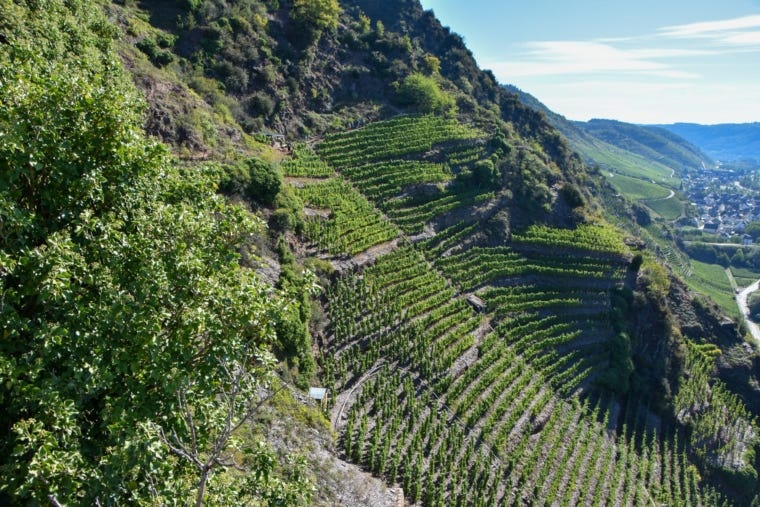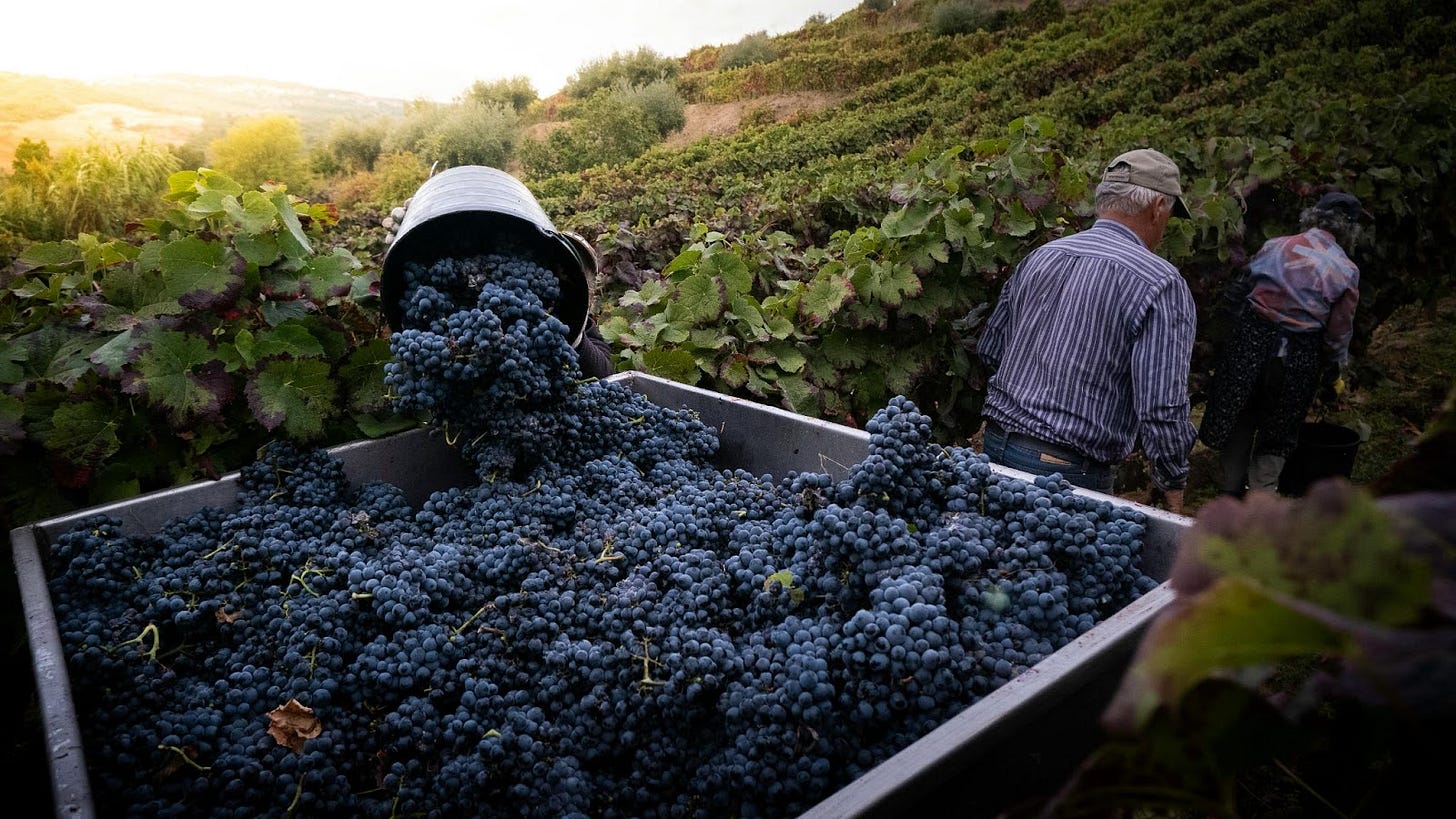Tannic Panic! Issue #120: Labor of Juice
Steep slopes, manual labor, and the juice from whence it came – ringing in Siptember with some great wines from some of the most labor intensive wine regions in the world.
Happy “it was Labor Day recently” from your friends here at Tannic Panic!™ A couple of weeks ago we talked about Sciacchetra, which comes from the Cinque Terre - notoriously one of the most challenging regions to produce wine from a labor perspective on account of its extremely steep and “rugged” landscape.
It’s one of many such regions in the “world of wine” that “stands apart” for its deep reliance on a “human workforce” that braves steep treacherous slopes, endures punishing conditions, and “performs” relentless manual labor to keep the vines thriving. These laborers are not a distant idea; their blood, sweat and tears (in that order) are a literal hallmark (“see tasting notes”) of every bottle produced, especially in places where mechanization simply isn’t possible and every fickle little grape demands a personal touch (LIKE ME!).
As such, this week we’re focusing our extremely limited capacity for attention on some of the most prominent high-labor regions of “the globe”: Mosel & Douro.
MOSEL - GERMANY:

The Mosel winds its merry little way through some of Germany’s most dramatic vineyard landscapes, where “impossibly steep” slate slopes rise directly from the humble riverbanks. The region’s geology, dominated by “Devonian” slate soil (whatever tf that means), plays a crucial role in shaping the wine’s “character” by providing excellent drainage (THE GOOD KIND), retaining daytime heat, and slowly releasing it at night (LIKE ME!). Here, mechanization (the “use of machines” to harvest the wonderful little “berries”) is a literal “pipe dream.” Instead, determined vineyard workers cling to the hillsides for dear life, tending vines and harvesting grapes with their “mighty hands,” often with little more than the help of “gravity” along with a wholesome dose of “determination” to guide them through the struggle. On the other side of their “hard labor” is some of the most delicate and expressive Riesling on “mother earth.”
TLDR
Vineyards rise at “dizzying angles,” often exceeding 60–70% slope. Workers sometimes have to use harnesses and pulleys just to stay upright while pruning or harvesting.
Machines can’t operate on those slopes, so everything from canopy “management” to grape picking is done by hand.
Add in fragile slate soils that crumble underfoot (like our collective “self-esteem”), and it’s as dangerous as it is laborious #HappyLaborDay
DOURO - PORTUGAL:

Shout out to Kate Reuschel (Survives on Wine) for reminding us that “it’s been a while” since we gave Douro the attention it deserves!
Carved into the proverbial cliffs that skirt the Douro River, the Douro region is perhaps most famous as a “fruit-source” for the “Port” (the don of the fortified game), but it also is the source of incredible dry reds and white wines. The Douro is the world’s oldest demarcated wine region, and its vineyards cling “like saran wrap” to steep, terraced slopes that demand near-constant “handual labor” to keep from crumbling to dust. Every stone wall, every step up the terraces, speaks to centuries of work that literally no machine could replace.
The focus of red Douro wines is five core grape varieties: Touriga Nacional, Touriga Franca, Tinta Roriz (Tempranillo), Tinta Barroca, and Tinta Cão. Touriga Nacional, the “star” of the bunch, produces itsy bitsy yields of itsy bitsy grapes that result in deeply pigmented, tannic, and aromatic wines that are far from “itsy bitsy” in flavor. Powerful, full-bodied, black-fruit driven, and layered with oak-derived spice in the best examples.
White wines, often from higher-altitude sites, offer a more refreshing counterpoint, with lively acidity and bright fruit. There are zillions of permitted white grapes by DOC law, but only a handful are widely planted or considered high quality. “Household names” such as Rabigato, Viosinho, Gouveio, Malvasia Fina, and Arinto are the so-called local heroes, with producers highlighting different combinations depending on vineyard altitude and style goals.
Regardless of their final “resting place,” Douro grapes grow in a landscape where handwork is the name of the game, and the wines carry the weight and reward of that effort.
TLDR
Terraced vineyards carved into the cliffs of the Douro River have been built and maintained by hand for centuries.
The terraces themselves require constant upkeep to prevent collapse, and the narrow ledges make tractors or harvesters impossible to use.
Picking grapes in the hellish summer heat can be brutal, with work often extending to the evening when temperatures are more forgiving (LIKE ME).
… AND NOW FOR THE REVIEWS (IN ORDER OF PRICE):
[CLICK HERE FOR A BREAKDOWN OF HOW OUR 100PT RATING SYSTEM WORKS]
Profile: Slate, green apple, underripe peach, lemon, lime, flowers, seashells
Palate: Dry, high (!) acid, medium- body, long finishExtremely “refreshing,” bone dry and EXTREMELY high acid Riesling with a great balance of slate “minerality,” green apple, citrus, and “elbow grease” (THE GOOD KIND!)
Score breakdown: Balance 36 / Aroma/Flavor 17 / Intensity 15 / Length 15 / Complexity 7 = 90 points (Z)
Profile: Blackberry, blueberry, black plum, black licorice, dark chocolate, tobacco, orange peel, juniper, walnut, mixed spice, wet stone
Palate: Dry, medium+ acid, high tannin, full body, long finishBlend: 55% Tinta Roriz (Tempranillo), 25% Touriga Franca, 10% Touriga Nacional, 10% “field blend of old vines” (THE GOOD KIND!)
Concentrated and structured, with black fruit, dark chocolate, spice, minerality, and early bottle-age complexities (tobacco, leather). The style nods to Bordeaux with hints of Ribera del Duero, so if you love those wines (LIKE US!), don’t miss this. A reminder: Douro reds deserve more of our “undivided” attention.
Score breakdown: Balance 37 / Aroma/Flavor 18 / Intensity 15 / Length 15 / Complexity 8 = 93 points (Z)
It’s important to remember that without the hard labor of the people who work the vineyards, we’d literally have nothing to drink. Here’s to them.
Until next time, HAPPY DRINKING PEOPLE.
Cheers!
Isaac & Zach
This issue of Tannic Panic brought to you by Labor day week — “It’s laborious™”







Loved this piece. And thanks for the shoutout!
Love all of these regions!